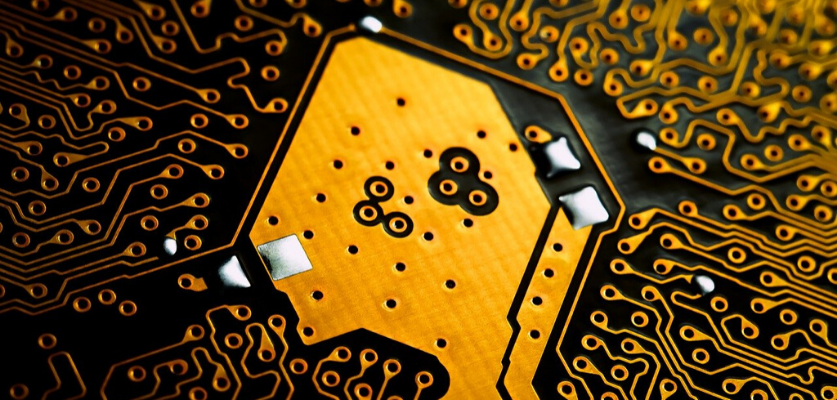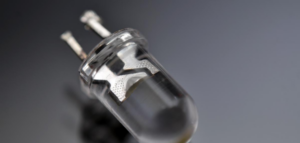More Ways to Create an Air-Tight Seal in Electronic Devices
Last time, we talked about the importance of achieving a vacuum-tight glass to metal seal in electronic products. Similarly, a method known as potting (also called encapsulation) is often used in manufacturing to create a tightly sealed package for electronic switching devices, including the flat ribbon in semiconductors used in solid state relays.
What is potting?
In potting, an electronic part or assembly is completely encased in a solid or gelatinous compound, both to provide resistance to shock and vibration, and to keep out dust and other contaminants, as well as moisture and corrosive agents. The method usually involves an electronic part being immersed in or injected with a liquid dielectric, such as silicone, epoxy, or urethane, and then cured. For void-free potting, a product can be placed in a vacuum chamber while the resin is still liquid; the vacuum is pulled and held to draw air out of internal cavities and the resin, then released so that atmospheric pressure collapses the voids and forces the liquid resin into very nook and cranny.
Dielectric potting is widely used for electronic performance and for protecting solid state electronic components from environmental and mechanical damage; as an added bonus, potting often also provides the structure that holds an assembly together.
Flat ribbon and semiconductors: the power behind solid state relays
Many of today’s switching applications employ a solid state relay (SSR) to control and complete power circuits — using a power semiconductor device on a flat ribbon to switch currents up to about 100 amperes. SSRs are faster than electromechanical relays; in addition, because there are no moving parts to wear out and no contacts to pit or build up carbon, SSRs have a longer life and a constant output resistance regardless of the amount of use.
Power semiconductors are made up of individual, discrete devices or, often, integrated circuits arrayed on a flat ribbon and used as a switch or rectifier for high current or high voltage applications, such as a switch-mode power supply. Some common power devices include the power diode, thyristor, MOSFET, and insulated-gate bipolar transistor (IGBT).
Heat sinks and removing heat from semiconductors
Since semiconductors don’t perform well at elevated temperatures, the power devices in SSRs require heat sinks to remove the heat that is generated by high temperatures and thermal cycling. Packaging provides a means for removing heat from a semiconductor device, by conducting the heat to the external environment. Attaching a power device to a heat sink also removes heat caused by operation losses. In addition, packaging helps to make semiconductor devices less sensitive to factors such as mechanical shock, vibration, humidity, and external magnetic fields.
Potting is often used to create the package for semiconductor components, including those using flat ribbon. Hermetic packaging can also be accomplished by positioning a semiconductor die in the cavity of a package and pulling a vacuum. The package is then sealed with a ceramic or metal cap.
As with a glass to metal seal, it is important to make sure the thermal expansion of the packaging material is compatible with that of the silicon semiconductor device. Likewise, it’s crucial to make sure the flat ribbon has no splits, cracks, or other surface conditions that could jeopardize the integrity of the sealed package. Careful visual inspection along with eddy current testing (ECT) can be performed on the flat ribbon to make sure it is free of surface and sub-surface flaws. (You can read more about ECT in our previous blog — or better yet, give Metal Cutting Corporation a call!)
In addition, where the potting resin is injected directly into the electronic component, it is important to make sure that the precision manufacturing equipment is correctly programmed to deliver the proper ratio of material and form an air-tight package without harming the delicate semiconductor device within.
Sealing the envelope in mercury switches
Another electronic device that is commonly potted is the mercury switch. As the name implies, mercury switches use a small amount of liquid mercury to open and close an electrical circuit. Because even a drop of mercury is very sensitive to gravity, mercury provides a unique sensing function for simple, low-force switching mechanisms.
Mercury switches consist of one or more sets of electrical contacts in a sealed glass envelope that contains a bead of mercury; the envelope may also contain air, an inert gas, or a vacuum. Mercury switches complete or break a circuit when the switch is tilted, causing the mercury to touch or move away from a set of contacts. The switch may contain multiple sets of contacts, closing different sets at different angles to sense movement in various directions.
Since mercury is a toxic metal whose use and disposal are tightly regulated, many former applications for mercury switches have been replaced over the years. For example, their use in new cars — for such things as lighting controls and anti-lock braking systems — was discontinued in the U.S. more than a decade ago. However, mercury switches still play a valuable role in safety devices such as tilt switches used for rollover or tip-over warnings in construction equipment. In aircraft, electrically driven attitude indicators (aka, artificial horizons) still use mercury switches to keep the gyro axis vertical. Mercury switches are also used as tilt alarms in some vending machines, activating a switch to sound an alarm if the machine is rocked or tilted.
The air-tight bottom line
Whether we’re talking about the glass to metal bond in a light bulb, the potted package of a semiconductor constructed with flat ribbon in a solid state relay, or the envelope in mercury switches, it is critical to ensure that the seal is air tight. Working with the right partners helps to ensure that critical electronic components and processes like these are tested along the supply chain, to produce the desired end results.
Do you need some advice on how to choose the best partners — ones that will meet your manufacturing needs, production deadlines, and quality standards for electronic components or other parts requirements? Download a free copy of our technical guide, 7 Secrets to Choosing a New Contract Partner.






